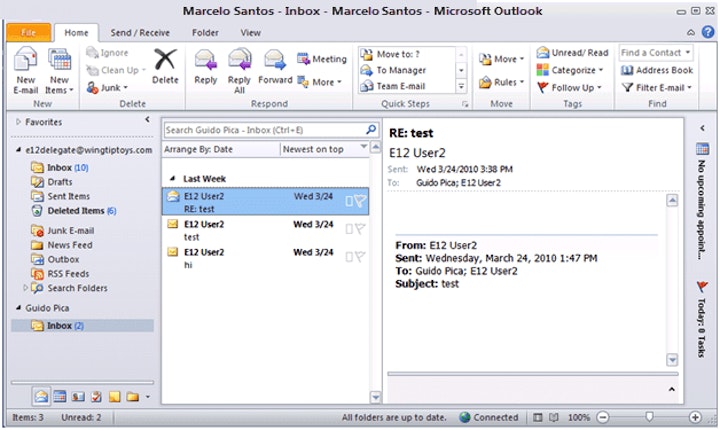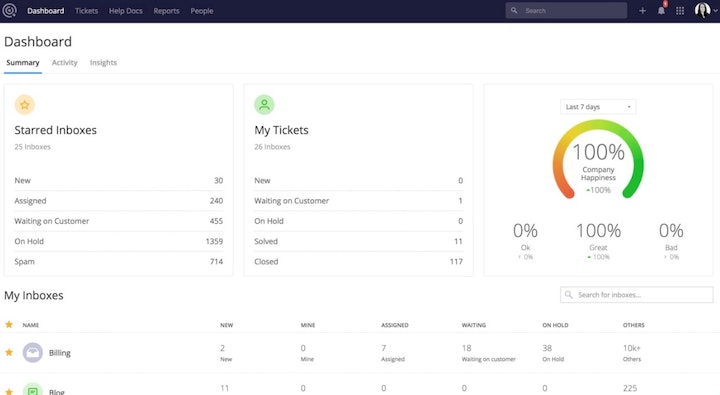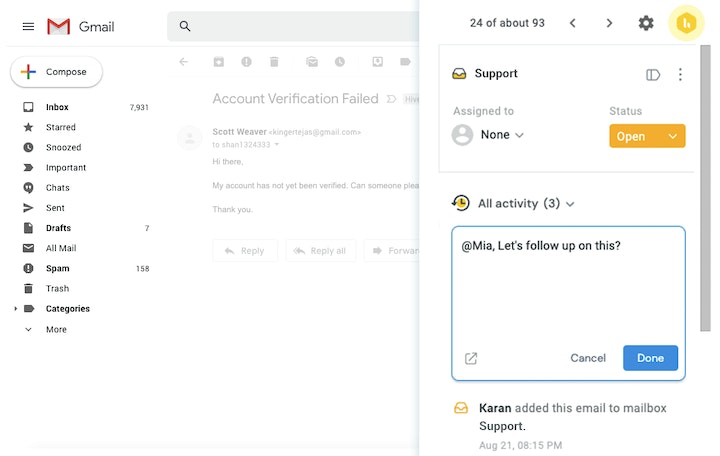The right email collaboration software can be a game changer for jobs like sales and support. After all, 75% of employers say team collaboration is essential.
Teams create group emails such as support@company.com to handle incoming emails with the goal of faster response times. But email was built as a one-to-one communication tool, not for sales and support teams to collaborate.
The problem is that a regular inbox doesn't tell you who's working on what, which can lead to multiple responses to the same question (or worse, no response at all) and can be challenging to manage. Email collaboration software helps you easily delegate tasks, speed up response times, and work smarter as a team.
To help you find the right option for your business, we've put together the nine best email collaboration software tools for teams, as well as some clarifying details around how to determine what will work best for your team.
The 9 best email collaboration software platforms
Help Scout
Google Collaborative Inbox
Outlook Shared Mailbox
Teamwork
Gmelius
Hiver
Rooftop
Front
Missive
1. Help Scout
Best email collaboration software for customer support.
Help Scout is an email collaboration software platform that provides customer support and builds customer relationships. Help Scout offers several features to help teams improve communication and collaboration via email, including:
A shared inbox — Give your team access to shared communication and customer requests. Easily tag conversations, get real-time updates, and share private notes with team members.
Automation — Create workflows to help automate repetitive tasks and conversations so your response times are lower and your customer experience is improved.
Saved replies — Responding to frequently asked questions using saved replies can reduce your time spent with each customer and provide consistency in communication.
Account tracking — Keep up with details about each customer and how their accounts have been handled in your Help Scout interface sidebar.
Integrations — Access integrations like Trello, Slack, Jira, Shopify, and Asana to streamline processes.
Along with our suite of tools, you also get access to our world-class support team. They’re ready 24x6 to assist with whatever you need. If you prefer self-led learning, we also offer a robust knowledge base to get answers on your own time.
Price: Free plan available. Paid plans starting at $50 per month.
2. Google Collaborative Inbox
Best email collaboration software for Gmail users.

If you have a small team already using Gmail, Google's Collaborative Inbox tool is a great option that will be easy for your team to implement.
Simply start a group that includes everyone in your Google account (or at least everyone who needs to access the collaborative inbox), then turn on Collaborative Inbox. From there, you can assign conversations to each other, resolve completed conversations, and categorize conversations using labels.
Google Collaborative Inbox is the most basic shared email tool out there for Gmail users, but it can be a great low-cost solution for teams that don't need additional features.
Price: Free for teams using Google Workspace.
3. Outlook Shared Mailbox
Best email collaboration software for Outlook users.

Outlook Shared Mailbox is similar to Google Collaborative Inbox, only for Microsoft users. This shared inbox functionality is meant to give multiple email users access to a single email account, like info@company.com or support@company.com.
This feature allows your entire team to send and receive emails from these generic email addresses without having to repeatedly sign in and out of their email apps.
If your team is looking for more in-depth online collaboration tools, Outlook Shared Mailbox likely isn't the best option for your business. But if you just need a basic option that lets your sales or support team access all emails in a single place, this could be it.
Price: Free for teams using Microsoft 365.
4. Teamwork Desk
Best email collaboration software for agencies.

Teamwork Desk is a team collaboration tool with help desk and email collaboration capabilities. It offers a number of features to help teams — especially agencies — work better together and ensure customer satisfaction, including team chat software, knowledge base management, and a CRM.
This is a great option for support teams or marketing agencies that need access to multiple collaboration tools in one.
Price: Starting at $8.50/user per month.
5. Gmelius
Best email collaboration software for teams who want more out of Google Workspace.

Because Google Collaborative Inbox is a bit lackluster in its feature offerings — and can also become a bit cluttered — Gmelius can be a great option for teams who want more out of Google Workspace. Gmelius works by inserting itself right into your Gmail window, saving your team from having to figure out a new piece of software.
Capabilities include workflow automation, the ability to turn emails into tickets and update their statuses, and the option to use Gmelius as a project management tool by turning your inbox into kanban boards.
Price: Starting at $7/user per month.
6. Hiver
Best email collaboration software for larger teams using Gmail.

Hiver is yet another Gmail-only collaboration tool for larger teams who are already using Gmail and want an easier way to manage customer emails.
Hiver comes with a number of features to help users manage their email inbox, from delegating emails and adding tags or notes to utilizing email templates and setting up automation. Hiver also has a mobile app to help teams keep up with communication on the go.
Price: Starting at $15/user per month.
7. Rooftop
Best email collaboration software for internal communication.

Rooftop is another great option for ensuring your team's email collaboration is as seamless as possible.
Rooftop's interface is designed to provide as much upfront information about each task or request as you need. Add labels to conversations, customize the columns that appear in your conversation dashboard, centralize all information about customers and clients, and access file-sharing capabilities.
Rooftop also calls itself a task management tool, helping teams whose roles center around communication treat various emails and customer requests as tasks.
Price: Starting at $39/user per month.
8. Front
Best email collaboration software for personal email use.

Front is a great tool for teams who want to access both their shared inbox and their personal inbox for email responses and follow-ups.
This tool provides real-time collaboration with instant messaging, so team members can work together to provide solutions to customers. It also offers automation, reporting, VIP customer prioritization, and more.
Price: Starting at $19/person per month.
9. Missive
Best email collaboration software for project management.

The last tool on our list is Missive, which combines email collaboration and project management. Missive offers a laundry list of features like signature personalization, conversation assignments, team inboxes, live chat, social media and SMS messaging, and integrations.
Price: Free plan available. Paid plans start at $14/user per month.
What is email collaboration software?
Email collaboration software allows multiple members of a single team to have access to a shared inbox. Every team member can get a complete overview of what is happening in the inbox, from tickets that need responses to information on volume across individual topics and tags.
While many smaller teams can survive using a personal email inbox, email collaboration software offers a ton of extra features that help teams improve the customer experience. Consider features like Help Scout's Collision Detection, which lets users know if another agent is actively working on a customer request to help prevent duplicate replies.
Email collaboration also facilitates team members working together in real time on projects such as new saved replies, bulk responses in the face of an outage or bug, and even documentation.
Who can benefit from an email collaboration tool?
While email collaboration tools can be beneficial for almost any team responding to customer or internal help inquiries, there are specific demographics for which they are best suited. For instance:
Large teams: If you have a lot of people on your team, lots of information can get lost in transit. Email collaboration platforms help keep information in your help desk and make it easy for everyone to stay on the same page.
Differentiated teams: If you have tiered out your customer experience strategy and have different groups that are all responding to different conversations, email collaboration can help keep that communication tidy.
Customer experience teams: For teams that handle multiple functions under the umbrella of customer experience, email collaboration tools can help keep every inbox under one roof.
Rapidly scaling teams: Snowballing teams don't always have a lot of time to train up-and-coming support folks. In cases where teams are growing quickly, an email collaboration tool can help onboard new team members by partnering them with seasoned employees.
Small teams with specializations: If you have a small group of specialists, email collaboration can make it easier for everyone to work together on a ticket rather than needing to stay in their silos.
Although these types of teams will benefit the most from using email collaboration tools, there are still some situations where other channels may better fit the customers’ needs.
Email versus other channels
As teams move forward in developing their customer experience strategies, they often start to debate adding other channels into the mix. Some of the other channels that businesses consider are:
Social media
Live chat
Text
Phone
Co-browsing
Video calls
While email can feel dull and old in the face of exciting new technologies, it is usually the first channel businesses try for a reason.
A support email address is one of the first things customers will look for outside of self-service support when they’re having trouble. There are a few ways that email is superior to some of the other communication channels you might use to help your customers:
Ability to dive deep
Some channels lend themselves better to technical troubleshooting, and email is one of them. It can be challenging to pull diagnostics, share screenshots and code snippets, or give technical instructions over social media, live chat, or the phone. In an email, the sender can include links to documentation, screenshots to bolster their directions, code snippets in text format, and even a quick link for cobrowsing. You can also customize the formatting and include embedded images.
If you’re offering more technical support or you’re looking for more clarity in your communication, email is a better channel than many others.
Security
If a customer needs to share personal data or verify their identity, it is safer to do so over email than via a channel like social media. In cases where data protection is crucial or your team needs a customer’s personal information, email is the more secure option.
Better collaboration
While specific software can help your team collaborate on social media and in chat responses, it is ultimately easiest to collaborate through email communication. All of the communication is right there for anyone’s reference, whereas communication by phone or via video chat has to be remembered and recorded by the agent after the fact. With a good email collaboration tool, you can also create internal notes, share links to conversations, and view saved replies that your team members have created.
Privacy and accuracy
Everything that happens on social media, outside of DMs, is public. If your responses don't go well with a customer, having a public trail can damage your reputation and, ultimately, your sales. Beyond that, old social media conversations can appear in Google search results and sometimes place higher than your documentation. If the information is outdated or incorrect, it can cause confusion and frustration for your customers.
Key features to look for in email collaboration software
What should you look for in email collaboration software? How can you know if you've found the right tool?
Every email collaboration tool worth its salt should include a few key features:
Real-time updates
Email collaboration tools should provide real-time updates on the status of emails. Real-time updates and notifications are the best way to guarantee no email or support request is overlooked and that everyone knows when someone has already been helped.
Private groups and discussion threads
Team members may need help with a response, so having a dedicated thread for private chats and discussions is a great collaboration feature in your email management tool.
Account tracking
When working with a team, it's essential to keep everyone accountable. Tracking who has handled each account is critical to running a smooth operation, regardless of whether it's for sales or support.
Personalization
Personalization is essential when your team is working together on a single platform to send out email communication or help customers resolve issues. Personalized customer support makes customers feel more in control of the conversation and minimizes feelings of stress and defeat.
Your email collaboration platform should allow users to add their signatures or display their names so people know who they're working with.
Integrations
Integrating your email communication tool with other third-party apps your team is already using helps streamline processes within your organization.
Find the best email collaboration software for your business
Email is an invaluable channel for customer support and sales teams, but it doesn't have to be a massive undertaking. Whether you're trying to declutter your inboxes, provide personalized customer support, or get real-time updates on messages, email collaboration software will help your team take their communication to the next level. For even more guidance, read our Buyer's Guide to Choosing the Right Customer Support Tool.











